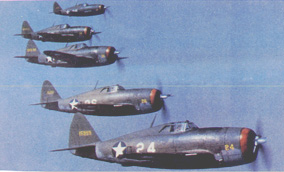Home Page
Republic P-47 Thunderbolt
United States | Bell P-39 | Bell P-59 | Bell P-63 | Brewster F2A | P-36 Hawk | P-40 Warhawk | F4F Wildcat | F6F Hellcat | F7F Tigercat | F8F Bearcat | P-38 Lightning | Lockheed P-80 | P-51 Mustang | P-61 Black Widow | P-47 Thunderbolt | F4U Corsair
P-47 Thunderbolt
Affectionately nicknamed "Jug," the P-47 was one of the most famous AAF fighter planes of WW II. Although originally conceived as a lightweight interceptor, the P-47 developed as a heavyweight fighter and made its first flight on May 6, 1941. The first production model was delivered to the AAF in March 1942, and in April 1943 the Thunderbolt flew its first combat mission--a sweep over Western Europe. Used as both a high-altitude escort fighter and a low-level fighter-bomber, the P-47 quickly gained a reputation for ruggedness. Its sturdy construction and air-cooled radial engine enabled the Thunderbolt to absorb severe battle damage and keep flying. During WW II, the P-47 served in almost every active war theater and in the forces of several Allied nations. By the end of WW II, more than 15,600 Thunderbolts had been built.
Production P-47B, -C, early -D and -G series aircraft were built with metal-framed "greenhouse" type cockpit canopies. Late -D series (dash 25 and later) aircraft and all -M and -N series production aircraft were given clear "bubble" canopies, which gave the pilot improved rearward vision.
This aircraft information is from the USAF Museum Archives
